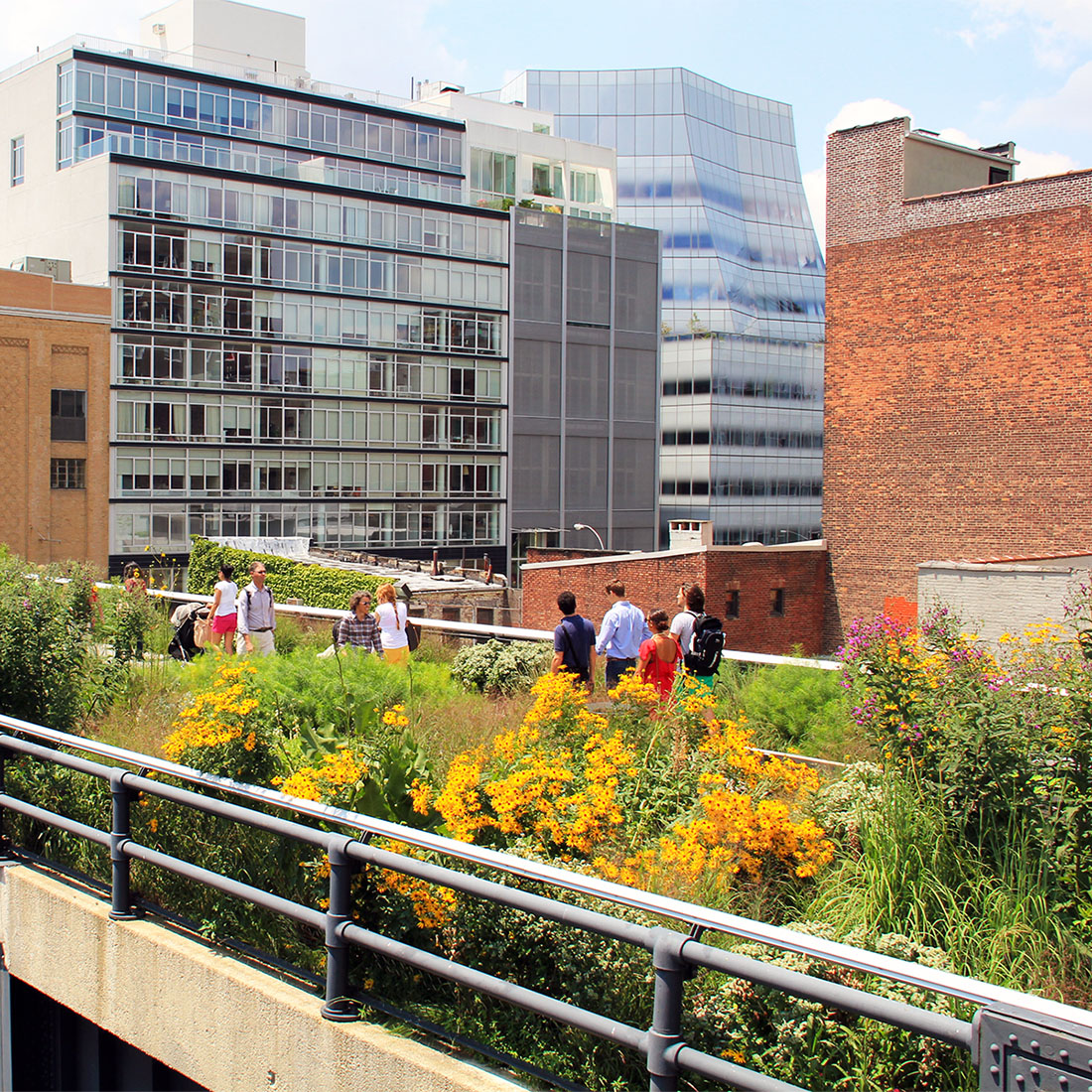WHO ARE OUR PARKS DESIGNED FOR?
HOW GREEN GENTRIFICATION AFFECTS OUR CITIES, AND WHAT URBAN DESIGNERS CAN DO ABOUT IT.
Parks improve our neighbourhoods, boost our health, strengthen our communities and combat the effects of climate change. Green spaces make our cities more liveable, but who really benefits?
Isabelle Anguelovski, director of the Barcelona Lab for Urban Environmental Justice and Sustainability (BCNUEJ), talked to me about their research on green gentrification and how we can green our cities without displacing communities.
Jardins de la Rambla de Sants: Barcelona’s version of the High Line is popular with the locals, who are also wary of green gentrification.
FROM GRASS-ROOT ACTIVISM TO CITY MAKING
Much of the push for greener and more sustainable cities originates in grass-root environmental activism, Isabelle Anguelovski explains. However, more recently, city marketing in larger, global cities has tended to appropriate the green city movement with large-scale developments driven by investors and elected officials. Hand in hand went a process of privatising green spaces and the emergence of high profile ‘feature’ landscape architecture that resulted in green spaces with high aesthetics but little community value. Some of the most noticeable examples are the New York High Line, the Boston Rose Kennedy Greenway or the new Les Halles park in Paris. Problematic is not only the lack of response to local community needs, but also that these type of large-scale green projects are usually associated with massive developments and urban regeneration of the surrounding neighbourhoods. In most cases, the result will be physical or cultural displacement of vulnerable parts of the local community in the area.
THE BARCELONA MODEL - PUBLIC SPACE AS URBAN BRANDING
The appropriation of planning processes through a public-private sector partnership prior to and after the Olympic games in Barcelona (1992), when large parts of the industrial heritage were erased to build the Olympic Village, marked a shift in the city’s urban design strategy. Public spaces and parks were now designed for visitors, city branding and to attract investment, rather than for its residents. This became known as the Barcelona Model. The Parc del Diagonal Mar (Enric Miralles and Benedetta Tagliabue), and the Parc del Centre de Poble Nou (Jean Nouvel), both in immediate proximity to Barcelona’s innovation district 22@, are examples for high profile green spaces as part of the city’s urban renewal strategy post-Olympics.
According to BCNUEJ research, signs of gentrification were present in around 60% of neighbourhoods with green spaces built between 1990 and 2008. Especially affected were those associated with large-scale developments on the waterfront.
AUSTRALIAN CITIES - VULNERABLE TO GREEN GENTRIFICATION?
While there are quantitative studies about the impact of green urban spaces on property values, there is little research on the possible gentrifying effect of greening strategies in Australian cities, as stated by Benjamin Cooke, lecturer in Sustainability and Urban Planning at RMIT University. A recent study reveals that in the urban area of Melbourne the presence of a playground within 300 metres adds about AU$20,000 (just under five per cent) to the average property price.
These trends in combination with a lack of strong public policy and the hijacking of the green agenda for the benefit of property developers give reason for concern for cities like Melbourne.
GREEN, BUT NOT AFFORDABLE
BCNUEJ ‘s research on 99 cities in North America and Europe with urban renewal strategies based on a green branding discourse has shown that while these cities have experienced economic growth, they might also become less affordable. While green gentrification not necessarily affects all cities or areas within a city, only those that coupled social equity with their urban greening programs were successful in avoiding property speculation and community displacement. In other cases, low-income residents, or even the middle class, were driven out.
So how can these research findings teach us to avoid green gentrification?
FOUR THINGS DESIGNERS CAN DO TO BUILD GREEN SPACES FOR ALL CITIZENS
1. BUILD MORE GREEN SPACES THROUGHOUT
Establish a network of green and blue spaces throughout the city so each citizen has access to high quality public green spaces and there are no “flagship” effect.
The French city of Nantes has successfully achieved a non-hierarchical mix of various types of smaller and larger parks, and public spaces. The city went through a trajectory of de-industrialisation at the end of the 1980s, with the conversion of the former shipyards at the centre of the urban reconstruction and economic recovery. Unused land was transformed into new civic infrastructure with an enormous quantity of small and large-scale green projects, a green living and working space with a strong focus on the creative industries. Overall the city doubled the amount of green spaces.
Barcelona is currently implementing a similar strategy to provide a network of green spaces with its Superblocks, with the ultimate goal to free up to 60% of the traffic area for public space. BCNUEJ cooperates with the city council to raise awareness of social inequity and gentrification with residents and stakeholders, and to take steps to improve community inclusion in the decision-making process and maintain accessible housing in the areas affected.
2. LESS FLAGSHIP AESTHETICS, MORE DIVERSE AND LOCALLY-DRAWN CHARACTER
Who is the client? When designers consider developers and city authorities as their clients, rather than the actual user, we often see ‘flagship’ parks as a result. Many of them are designed in a contemporary, designer-specific style that fails to emphasise the local character of the neighbourhood. To foster a connection between the community and green spaces and landscapes, designers have to base green spaces and infrastructure upon the residents’ various needs, preferences, and identities. Green infrastructure should also not be a technical, quantitative approach, but has to consider the emotive and experiential factor.
As seen with New York’s High Line, if a park is not designed according to the community’s requirements, they will not use it - but others will.
“When we opened, we realised the local community wasn’t coming to the park, and the three main reasons were: they felt it wasn’t built for them, they didn’t see people like them there, and they didn’t like the programming.”
3. COMMUNITY ENGAGEMENT AND CO-CREATION
Engaging methodologies and democratic processes are needed to involve the community and co-create green spaces. This can include tactical urbanism, social media strategies, workshops and community activities. An ongoing conversation not only with residents, but also other stakeholders and municipal actors from different sectors is critical for the development of environmentally and socially sustainable green spaces. We need to create dynamic spaces that the residents can make their own and that are adaptable to the changing needs of the community.
The City of Melbourne’s Urban Forest Strategy is an example for the use of communication and citizen engagement tools, and a holistic and multi-disciplinary approach that allows people to build a relationship with nature in the city.
4. LOOK AT THE BIGGER PICTURE
Urban greening strategies need to be linked to government policies, housing regulations and zoning laws.
In Nantes, development was driven by the city, not the developers, through the application of land-use control and inclusionary zoning regulations. A public private partnership was set up to direct the development and regulate uses, including the provision of social and mixed housing. Financing schemes for rent and mortgages were set up for low and middle class residents.
In Barcelona, the proportion of public and social housing compared to the overall housing stock is much lower than in Nantes. But the city is pushing for a social housing quota of 30% for every new development. Stronger public policies and green and social governance will be required in both Spain and Australia to respond to the risk of social inequity when making our cities more liveable and sustainable. As landscape architects and urban designers we can promote the inclusions of these types of mechanisms through our project work with clients and stakeholders, local governments and advocacy through professional associations.
The bottom line is - green infrastructure and public space is never apolitical. We as designers are in the middle of it and should not shy away from taking a position. What do you think?
A modified version of this article featured in online magazine Foreground.










